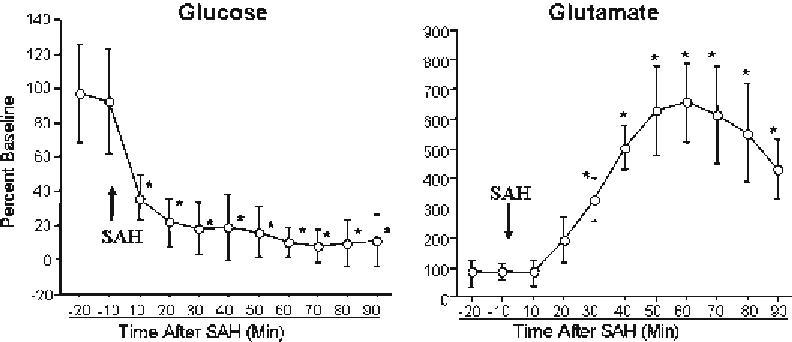Biology Reference
In-Depth Information
Fig. 2. Changes in cerebral environment during the after 90 min after SAH. Cerebral glucose concentration falls and
glutamate concentration increases minutes after SAH. Data is presented as percent baseline; mean ± SEM,
n
= 6,
*
P
< 0.05.
does not contain proteins a protein clean up or protection of sample
against ex vivo enzymatic degradation is not required.
Disadvantages of this technique are that: (1) probe implanta-
tion procedure is invasive and may cause injury to the brain tissue,
(2) depending upon the method used, detection of dialysate can be
costly, (3) it provides relative concentration of substrate and to
calculate true concentration in vivo recovery of substrate need to
be determined, and (4) sensitive analytical method for detection is
required for detection of substance that are present is in small
quantity.
Since probe is implanted into the brain stereotactically, a stiff probe
is a better choice then a fl exible probe. Selection of probe membrane
depends upon the molecular weight and permeability to substance
of interest. Probe membranes are made up of cellulose, copolymers,
acrylic copolymers, or polysulfone. Typically, membranes with a
pore size that allows diffusion of water soluble molecules with a cut
off weight of 5-50 kDa are used for cerebral microdialysis.
CMA 11, and CMA-12; stiff probe, polyethersylphone mem-
brane (CMA microdialysis; Solon, Sweden) with a cut off weight
20,000-100,000 Da have been used successfully for assessing cere-
bral ischemic metabolites in rats after SAH (
27, 28, 35
).
4.2. Main
Considerations
4.2.1. Choice of Probe
and Membrane
The movement of substances across microdialysis probe membrane
relies on the concentration gradient between the interstitial fl uid
and the perfusate. Hence, it is important that the composition of
perfusate mimics the fl uid being sampled. A number of physiologi-
cal salt solutions, including Krebs-Ringer solution and artifi cial
cerebral spinal fl uid (CSF) have been used for cerebral microdialy-
sis (
27, 29
).
4.2.2. Perfusate
(Composition, pH and
Temperature)

Search WWH ::

Custom Search